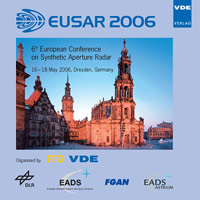Position Estimation of Moving Vehicles for Space-based Multi-channel SAR/MTI Systems
Conference: EUSAR 2006 - 6th European Conference on Synthetic Aperture Radar
05/16/2006 - 05/18/2006 at Dresden, Germany
Proceedings: EUSAR 2006
Pages: 4Language: englishTyp: PDF
Personal VDE Members are entitled to a 10% discount on this title
Authors:
Ender, Joachim H. G.; Cerutti-Maori, Delphine (Forschungsinstitut für Hochfrequenzphysik und Radartechnik (FGAN-FHR), Neuenahrer Straße 20, D-53343 Wachtberg)
Abstract:
Ground moving target indication (GMTI) by a space-based radar system can be obtained by a multi-subaperture / multichannel radar system or a satellite cluster. The simplest approach with the receiving antenna split into two halves - and most popular in the SAR community - is to use the technique of along-track interferometry (ATI) to recognize moving objects. Caused by the ambiguity between radial velocity and azimuth position, the SAR processor images the moving object at a wrong position. Re-positioning can be performed by the exploitation of the interferometric phase; but, if the clutter contribution from the affected resolution cell is not negligible compared to the signal power, a severe estimation error will result. A larger number of subapertures permits a better performance using space-time adaptive processing (STAP), but a larger number of receive channels is not attractive for space-based systems because of weight, power consumption and data rate. Nevertheless, since phased array antennas offer the possibility to switch the phases and amplitudes of the T/R modules from pulse to pulse within each subaperture, additional degrees of freedom can be introduced increasing the performance considerably. In this paper, space-based multi-aperture radar systems will be analysed with respect to the relocation error, including time-multiplexed aperture switching techniques. Moreover, an azimuth estimation algorithm for this mode is investigated.


